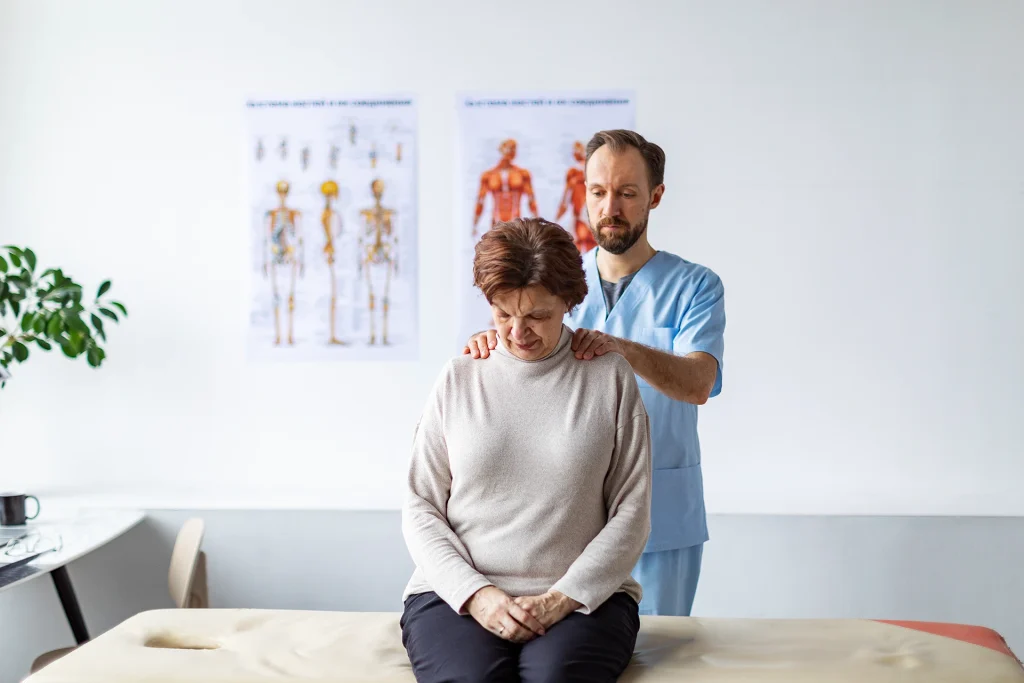Do you ever experience aching, stiffness, or tenderness at the base of your skull or upper neck?
This frustrating sensation is very common, with most of the general population experiencing it at some point in their lives. While neck pain can originate from injuries or medical conditions, poor posture and constant smartphone usage make mild back of neck discomfort an everyday occurrence for many people.
Yet this nagging pain prevents you from fully enjoying life and activities when it flares up. Your neck mobility suffers. Headaches kick in. Sleep becomes difficult and work productivity plummets. The impact of back of neck pain, even if seemingly minor, should not be underestimated.
The good news? Various treatments and lifestyle remedies can help manage and prevent recurrences of back of neck pain.
With a strategic approach, you can successfully reduce neck pain episodes and maintain healthy cervical mobility long-term.
Understanding the Anatomy of Your Neck
The neck contains an intricately connected network of bones, discs, nerves, muscles, tendons, and blood vessels that all work together to support the head and allow mobility.
Key structures include the top seven spinal vertebrae (C1-C7), intervertebral discs between each vertebrae, facet joints, spinal cord and nerve roots, throat muscles, blood vessels, and layers of neck muscles like the trapezius, sternocleidomastoid, and levator scapulae.
Disruptions to any of these delicate parts can manifest as pain at the back of the neck. Muscle strain is a common culprit, but spinal arthritis, disc herniations, bone spurs, or pinched nerves are also frequent sources of neck pain.
What Causes Pain at the Back of the Neck?
Before exploring treatments, it’s important to understand what’s causing pain at the back of your neck in the first place. Here are some of the most common culprits:
Poor Posture
One of the leading causes of neck pain is poor posture. Slouching at a desk, hunching over a phone or computer, or even sleeping in a strange position can strain the muscles and joints in the neck and upper back.
Over time, poor posture alters the spine’s natural alignment and curvature, placing excess pressure on the cervical vertebrae and soft tissues of the neck.
Muscle Strains
Repeated movements or improper lifting and carrying can cause strains or sprains in the network of muscles that support the head and neck.
Common problem areas include the trapezius muscles between the neck and shoulders and the levator scapulae muscles of the upper back. Muscle strains trigger inflammation, spasms, and localized pain.
Whiplash Injury
A whiplash injury, usually from a motor vehicle accident, involves hyperextension of the neck and a rapid back-and-forth motion. This type of trauma overstretches the muscles, tendons, and ligaments, resulting in pain, stiffness, and muscle spasms. Whiplash injuries are a common cause of both acute and chronic neck pain.
Degenerative Disorders
Wear-and-tear from aging can cause cervical spondylosis, or degenerative arthritis of the spinal vertebrae and discs. As these structures break down, they may press on nearby nerves, resulting in pain and numbness. Spinal stenosis, a narrowing of the spinal canal, also becomes more common with age.
Herniated Discs
Discs act as shock absorbers between the cervical vertebrae. A herniated disc occurs when a disc’s outer wall ruptures, allowing the gel-like inner material to bulge out. A herniated disc in the neck region can irritate spinal nerves and cause severe inflammation and pain.
Pinched Nerves
Cervical radiculopathy, more commonly known as a pinched nerve, happens when surrounding bone, disc material, or soft tissues compress the nerve roots exiting the cervical spine. This causes pain, tingling, or numbness traveling down the arms, shoulders, and upper back.
Muscle Tension
Chronic muscle tension accumulating in the neck and shoulders frequently manifests as pain at the base of the skull. Tight neck muscles often result from poor posture, emotional stress, or overuse from repetitive motions. The pain worsens as the tense muscles press on surrounding nerves.
While these are among the most prevalent causes, other medical conditions like meningitis, bone spurs, thyroid disorders, and even cancer or tumors sometimes trigger neck pain.
A number of factors can increase susceptibility to neck pain episodes. Below is a table highlighting these factors:
| Factor | How it Contributes to Neck Pain |
| Age | Age-related spinal degeneration |
| Low Fitness Level | Weak neck muscles, poor posture |
| Poor Ergonomics | Repetitive strain on neck |
| Prior Injury | Increased risk of later arthritis, pain |
| Genetics | Hereditary conditions like spinal disorders |
What Symptoms Are Associated With Back of Neck Pain?

The specific symptoms accompanying neck pain can provide clues as to the underlying cause. Here are some characteristic symptoms of back of neck pain:
- Aching, sharp, or piercing pain at the base of the skull that may radiate to the shoulders or upper back
- Stiffness and reduced range of motion when turning or tilting the head
- Dull pain or soreness concentrated in the trapezius muscles of the upper back and neck
- Shooting or stabbing pains from the neck into the head, shoulders, and arms
- Tingling or numbness traveling down the arms and fingers
- Muscle tightness and painful spasms, especially along the neck and shoulders
- Headaches originating at the base of the skull and radiating forward
- Dizziness or lightheadedness when moving the head
- General weakness, fatigue, and performance impairments of the arms and hands
Keep in mind that additional symptoms like fever, unexplained weight loss, loss of bladder control, or difficulty walking may indicate a more serious underlying condition. Seek prompt medical attention if any severe or concerning symptoms accompany your neck pain.
Chronic vs Acute Neck Pain
Neck pain is considered acute when it lasts less than 3 months, often caused by minor strains, sprains, poor posture, or injuries. Acute pain usually resolves with rest and conservative treatment.
Chronic neck pain persists for over 3 months and is often attributed to degenerative disorders like spinal arthritis, disc degeneration, osteophyte bone spurs, or spondylosis.
Chronic pain is also more resistant to treatment and may require physical therapy, steroid injections, medication, massage therapy, or spinal surgery.
Treating Acute Back of Neck Pain at Home
For mild to moderate cases of acute neck pain without serious complications, trying home care first is appropriate. Follow these tips for managing back of neck pain flare-ups:
Use Cold Compresses
Applying cold packs wrapped in a towel to the sore muscles can reduce inflammation and dull pain signals. Use for 15-20 minutes several times a day.
Take OTC Medications
Anti-inflammatories like ibuprofen or naproxen can ease acute muscular neck pain. Acetaminophen also reduces pain, but has less anti-inflammatory effect. Avoid overuse.
Get Plenty of Rest
When neck pain flares up, alter activities to give muscles a break. Adjust workstations and avoid positions that aggravate pain. Get extra sleep so muscles can heal.
Try Gentle Stretches
Light range-of-motion stretches and neck exercises help relieve stiffness, loosen tight muscles, and promote healing blood flow. Start slowly and avoid pain.
Utilize Topical Analgesics
Creams, gels, patches, or roll-ons with menthol, capsaicin, lidocaine, or other analgesics can temporarily numb or distract from neck pain when applied to the skin.
Make Ergonomic Changes
Review your workspace and sleeping area to identify adjustments that might relieve neck strain, like monitor height, pillow support, or lighting.
Focus on Relaxation
Try calming activities before bed like reading, music, or meditation. To sleep comfortably, use an extra pillow for support, avoid stomach sleeping, and keep your neck aligned.
Seeing fast relief from home remedies? Keep up these positive habits even after pain subsides to avoid recurrence. But if severe symptoms persist for over a week with no improvement, contacting your doctor is wise. Don’t neglect troubling neck pain.
When to Seek Medical Treatment for Neck Pain
Home care strategies should provide some relief for simple neck pain within 1-2 weeks. Call your doctor promptly if any of the following occur:
- The pain worsens or fails to improve with rest and OTC treatment
- Numbness, tingling, or weakness makes daily tasks difficult
- You experience shooting pains, headaches, nausea, or dizziness
- Pain interferes with sleep, work, and normal daily activities
- You have a history of serious medical conditions or recent trauma
- Swallowing, walking, coordination, or bowel/bladder function become impaired
Severe neck pain or red flag symptoms could signify serious injury or illness requiring medical intervention. Your doctor can administer prescription treatments, refer you to specialists, and arrange advanced imaging or testing if appropriate.
Wrap It Up: Achieving Relief for Back of Neck Pain

For even more customized neck pain relief plans, the healthcare professionals at Kaly are available to assess your unique situation and design tailored treatment programs just for you. Their one-on-one guidance can help diagnose the root cause of your pain.
